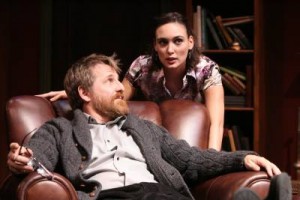
Willy Russell’s Educating Rita is probably best known to Americans as the 1983 film which starred Michael Caine as alcoholic Professor Frank Bryant and introduced Julie Walters to the world as hairstylist turned open university student Susan “Rita” White, a role which won her the Golden Globe award and an Oscar nomination.
Twenty-five years later, two-time Ovation Award nominee Rebecca Mozo could easily find herself in awards competition once again for her splendid reinvention of the role in the Colony Theatre’s hugely entertaining revival/revisal of Russell’s original stage version, starring an equally fine Bjørn Johnson as Frank and directed with expected finesse by Trying’s Cameron Watson.
Arriving for her first private tutoring session with Dr. Bryant, a punkish Rita promptly informs the rumpled, bearded professor, “I’m not a Susan anymore. I’ve called meself Rita — y’ know, after Rita Mae Brown.” And when Frank stares back blankly, she clarifies, “Rita Y’ know, Rita Mae Brown who wrote Rubyfruit Jungle!”
Just who exactly Rita Mae Brown is is not the only lesson Rita White teaches Frank in the course of Russell’s delightful two character play.
Frank’s reason for taking this latest assignment is a simple one—to pay for the numerous bottles of hard liquor he keeps methodically filed behind various books in his university office. Rita, on the other hand, is taking this new step in her life quite seriously indeed. When asked how much she wants to learn, Rita responds without hesitation “Everything,” and when Frank comments that this is a great deal to learn, she explains:
“It’s like y’ sit there, don’t y’, watchin’ the ballet or the opera on the telly an’ — an’ y’ call it rubbish cos that’s what it looks like? Cos y’ don’t understand. So y’ switch it off an’ say, that’s fuckin’ rubbish.”
It’s not just that this working class hairdresser, who swears like a sailor, “gets” that people put down the things that they don’t understand. There’s also the matter of the baby her husband has been after her for two years to conceive. “See, I don’t wanna baby yet,” she tells Frank. “See, I wanna discover meself first.”
Reluctantly Frank agrees, on one condition. “I’ll tell you everything I know,” he promises Rita, “but if I do that you must promise never to come back here.” “Listen,” Rita responds, “I’m on this course, you are my teacher — an’ you’re gonna bleedin’ well teach me.”
And so, over the course of the next months, Rita becomes a regular visitor to Frank’s office in her attempt to “change from the inside.” At first she seems more interested in inquiring about Frank’s personal life or discussing her own. But little by little, Rita’s intellectual curiosity awakens as does her interest in Ibsen and Elliot and Forster. As time passes, Rita does indeed begin to change, and not only from within. This black leather-wearing punkette begins to soften her makeup and add color and femininity to her wardrobe, outward changes which reflect her inner growth, both intellectually and as a woman. As her marriage begins to disintegrate, she tells Frank, “I can get through the rest of the week if I know I’ve got comin’ here to look forward to.” And though Frank would be the last to admit it, he too begins to look forward to Rita’s visits almost as much as she does.
Russell jam-packs his script with one-liners, with Rita and Frank alternating as straight man. When Rita remarks on the nude painting that hangs above Frank’s fireplace, a painting Frank hasn’t even noticed in years, she quips, “Y’ don’t paint pictures like that just so that people can admire the brush strokes, do y’?” And later, when Frank corrects her for pronouncing E. M. Forster as “Foster,” she comes back with, “‘Forster’ to do what?” to which Frank responds, “I don’t think he would have forced her to do anything.” (Forster was gay, you see.)
This last exchange does not appear in the Samuel French original, perhaps an instance of Russell’s “new and updated” script, of which the Colony is presenting the first American production.
With Watson at the helm and Mozo the leading lady, Educating Rita could well repeat the critical and popular success of Trying, last year’s monster hit for the Colony, with one slight difference. In Trying, it was the male protagonist who got the plum role. This time, the play belongs to the luminous and enchanting Mozo. This is not to imply any criticism of Johnson’s excellent work here. He’s pitch perfect as the college prof sliding rapidly downhill in an alcoholic haze. But if ever a character could be called colorful, it is Rita, and Mozo plays her for all she’s worth and proves again why she’s quite possibly the most in-demand young actress in our richly populated Los Angeles stage scene.
Like a young Meryl Streep (think back to Streep’s film roles in the early 80s), Mozo is a leading lady/chameleon whose mastery of accents allows her to transform herself into character after character, from a young Turkish girl in Pera Palas to an educated young Englishwoman in I Capture The Castle to a Bronx nun in Doubt and now to a Liverpudlian hairdresser in Educating Rita. Like Streep, Mozo’s talent is far greater than an ability to do accents, and much of the pleasure in watching Educating Rita is in observing the many colors Mozo brings to the role and the subtle (as well as the not so subtle) changes that take place in Rita over the course of the play.
Most of the Trying design team is back for Rita and doing equally fine work here. I’m not sure a British professor’s office would be as expansive as the one Victoria Profitt has designed to fill the Colony stage, but if so, a lucky man he, for this office is so richly detailed as to provoke “Aah’s” from the audience at first glance. Jared A. Sayeg’s exquisitely subtle lighting is a 180 degree change from his Vegas-esque tour de force in the recent The Who’s Tommy, but every bit as accomplished in its mastery of the craft. Cricket S. Myers has designed the sound (along with Rebecca Kessin), a guarantee of excellence, and John Swihart’s lively/lovely original music fills the show’s many blackouts. Terri A. Lewis’s costumes are perfection, from the simplicity of Frank’s wardrobe (the sweater goes on, the sweater comes off) to the dozens of outfits Rita wears (a new one for each scene), clothes which provide outward evidence of Rita’s inward changes.
In the lobby during intermission at a recent Colony production, while looking at color photos from the Colony’s 30 plus seasons, I happened to overhear a young audience member remark longingly to her friend, “They used to do big shows here.” I share her nostalgia for the days of The Man Who Came To Dinner, You Can’t Take It With You, and On The Twentieth Century and miss the large casts and multiple relationships they presented to Colony audiences. Still, Educating Rita proves that a two-hander can be as richly entertaining and rewarding experience as a play with a “cast of dozens.” Like Trying, Educating Rita is a winner from start to finish.
The Colony Theatre, 555 North Third Street, Burbank.
www.colonytheatre.org
–Steven Stanley
August 23, 2008
Photos: Michael Lamont




 Since 2007, Steven Stanley's StageSceneLA.com has spotlighted the best in Southern California theater via reviews, interviews, and its annual StageSceneLA Scenies.
Since 2007, Steven Stanley's StageSceneLA.com has spotlighted the best in Southern California theater via reviews, interviews, and its annual StageSceneLA Scenies.







 COPYRIGHT 2024 STEVEN STANLEY :: DESIGN BY
COPYRIGHT 2024 STEVEN STANLEY :: DESIGN BY